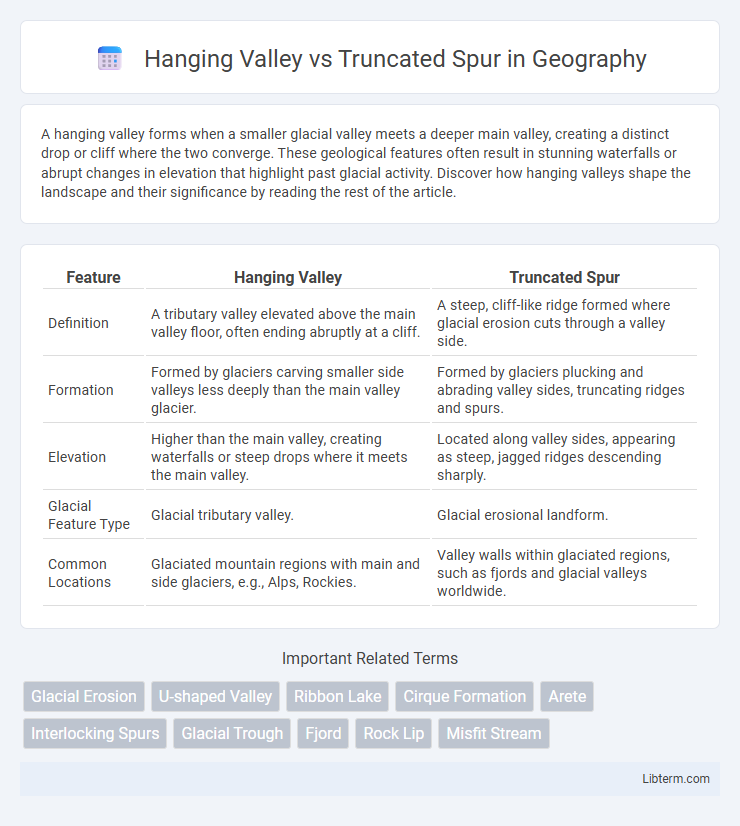A hanging valley forms when a smaller glacial valley meets a deeper main valley, creating a distinct drop or cliff where the two converge. These geological features often result in stunning waterfalls or abrupt changes in elevation that highlight past glacial activity. Discover how hanging valleys shape the landscape and their significance by reading the rest of the article.
Table of Comparison
| Feature | Hanging Valley | Truncated Spur |
|---|---|---|
| Definition | A tributary valley elevated above the main valley floor, often ending abruptly at a cliff. | A steep, cliff-like ridge formed where glacial erosion cuts through a valley side. |
| Formation | Formed by glaciers carving smaller side valleys less deeply than the main valley glacier. | Formed by glaciers plucking and abrading valley sides, truncating ridges and spurs. |
| Elevation | Higher than the main valley, creating waterfalls or steep drops where it meets the main valley. | Located along valley sides, appearing as steep, jagged ridges descending sharply. |
| Glacial Feature Type | Glacial tributary valley. | Glacial erosional landform. |
| Common Locations | Glaciated mountain regions with main and side glaciers, e.g., Alps, Rockies. | Valley walls within glaciated regions, such as fjords and glacial valleys worldwide. |
Introduction to Hanging Valleys and Truncated Spurs
Hanging valleys form when smaller tributary glaciers merge with a larger glacier, leaving their valleys elevated above the main valley after glacial retreat. Truncated spurs are steep, cliff-like ridges eroded by glaciers cutting across river valleys, resulting in blunt, steep edges. Both features reflect the powerful sculpting effects of glacial erosion on mountainous landscapes.
Geological Formation Processes
Hanging valleys form when smaller tributary glaciers join a main glacier, carving shallower valleys that remain elevated above the primary valley floor after glacial retreat. Truncated spurs develop as powerful glacial ice abrades and steepens the sides of interlocking ridges, truncating the spurs into steep cliffs. Both features result from differential erosion during glaciation, with hanging valleys indicating tributary glacier dynamics and truncated spurs reflecting the main glacier's erosive power.
Key Characteristics of Hanging Valleys
Hanging valleys are characterized by their elevated position above the main valley floor, often formed by differential glacial erosion where smaller tributary glaciers fail to erode as deeply as the main glacier. These valleys typically feature steep cliffs or waterfalls at their junction with the main valley, highlighting a pronounced vertical drop. In contrast, truncated spurs are landforms with steep, cliff-like edges produced by glacial erosion that cuts off the ends of interlocking spurs, without the elevated, "hanging" aspect seen in hanging valleys.
Distinctive Features of Truncated Spurs
Truncated spurs are characterized by their steep, cliff-like edges formed by glacial erosion, contrasting with the more gently sloping sides of hanging valleys. These features occur when glacier ice cuts through and removes the tips of interlocking spurs, creating a straight valley wall. Unlike hanging valleys, which are perched above main valley floors due to differential erosion, truncated spurs directly illustrate the glacier's erosive power and path.
Formation Mechanisms: Glacial Erosion Explained
Hanging valleys form when smaller tributary glaciers erode their valleys less deeply than the main glacier, leaving these tributary valleys suspended above the primary valley floor after glacial retreat. Truncated spurs result from the main glacier's powerful erosive force, which cuts off and steepens the edges of interlocking spurs, creating cliff-like landforms along the valley sides. Both features illustrate differential glacial erosion where varying ice thickness and flow velocity influence valley morphology.
Visual Differences: How to Identify Each Landform
A hanging valley is visually identified by its elevated position above the main valley, often marked by a sharp drop-off or waterfall where the tributary glacier once flowed, creating a distinct step-like formation in the landscape. In contrast, a truncated spur appears as a steep cliff or ridge abruptly cut off by glacial erosion, with smooth, polished rock faces indicating the glacier's passage. The key visual difference lies in the hanging valley's elevated, plateau-like floor versus the truncated spur's sharply eroded, steep slope.
Real-World Examples: Notable Hanging Valleys
The Hanging Valley of Yosemite National Park in California is a classic example, formed by glacial erosion where a smaller tributary glacier met a larger one, resulting in a valley that abruptly ends above the main valley floor. In contrast, the Truncated Spur found in the Alps represents a glacially eroded ridge, where cirque glaciers cut off the ridges between valleys, creating steep, cliff-like faces. Notable hanging valleys often host picturesque waterfalls, such as Bridalveil Fall in Yosemite, demonstrating the dramatic elevation difference characteristic of these features.
Famous Locations Featuring Truncated Spurs
Famous locations featuring truncated spurs include the Yosemite Valley in California, where glacial activity has sculpted steep, cliff-like landforms. The fjords of Norway, such as Geirangerfjord, also showcase striking truncated spurs shaped by glacial erosion. These truncated spurs contrast with hanging valleys, which typically form elevated side valleys above the main valley floor.
Ecological and Hydrological Significance
Hanging valleys create unique microhabitats supporting diverse alpine flora and fauna due to their elevated positions and limited soil erosion, enhancing biodiversity in mountainous ecosystems. In contrast, truncated spurs influence watershed dynamics by redirecting river flow and sediment deposition, shaping downstream aquatic habitats and nutrient cycling. Both landforms play crucial roles in maintaining ecological balance and hydrological processes within glacial landscapes.
Hanging Valley vs Truncated Spur: Comparative Summary
Hanging valleys are elevated side valleys formed by differential glacial erosion, where smaller tributary glaciers meet a larger glacier, leaving a steep drop at the junction. Truncated spurs are steep, cliff-like ridges that have been abruptly cut off by glacial erosion as the glacier carves through pre-existing river valleys. Compared to truncated spurs, hanging valleys create waterfalls or steep cliffs where meltwater flows, while truncated spurs represent the reshaped, eroded remnants of former valley sides.
Hanging Valley Infographic

 libterm.com
libterm.com